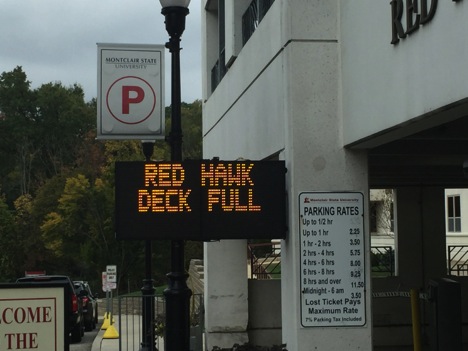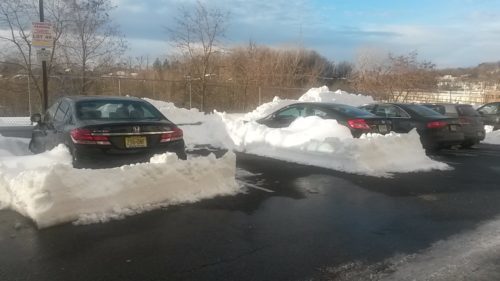Every morning, Montclair State University transforms into a racetrack as students pour in desperation to track down a parking spot. Parking has been an issue for the school since 1908, and as the student population has reached a new high of 21,000 this year, faculty, staff and students are left to wonder how this influx of students is going to impact the already tense parking situation.
Laura Ortiz, a junior business major at Montclair State, attempts to make it to campus about an hour before every class just to find a parking spot. “Last week I tried to get here 45 minutes earlier than usual in order to practice my speech for class. I figured it would take me 20 minutes tops to find parking and the rest of the time I would practice. Turns out after an hour at Car Parc [Diem] there was no parking and I had to go over to Red Hawk Deck and pay for parking (after paying for a permit) and ended up being late to class.”
This is a story that seems to keep repeating itself: students are unable to find parking and end up either being late or being so late that going to class is pointless.
Aside from the lack of parking, some Montclair State faculty have strict attendance policies. Recurring tardiness in some classes can add up and drop a student’s average by half a letter grade.
Residential student Alexis Adermarch, a junior English major, is afraid of becoming a commuter student due to the stories her commuting friends share with her. “Many of my friends are commuters and tell me horror stories about their parking,” she said. “In fact, one of the big reasons why I decided to live on campus again this year was to avoid these ordeals. Within the first week, my one friend could not find any parking whatsoever and was forced to miss the first day of the one class we are in together.”
Though Adermarch is thinking of becoming a commuter student due the expense of being a resident, she fears that the parking situation will affect her studies.
Although administration feels that it is the students’ and faculty’s responsibility to make it to campus on time, there are still issues that don’t just pertain to the amount of parking spots. According to junior English major Lyndsey Larmony, parking is “a complete wreck. There are never enough spots in Car Parc Diem [and] Lot 60 is always full. The buses are not on a schedule, so in the middle of winter it is it extremely irritating to have to wait for the bus, which is usually always full if you’re waiting in The Village for a ride onto campus.” Students complain they should not have to come two hours early just to receive the expensive education they paid for.
Parking on campus is not just a matter of the amount of spaces versus the amount of faculty, staff and students. Mariella A. Diaz, the director of parking services, stated that there are 3,755 lot spots for commuters, 1,225 for faculty and 1,500 for residents. While there are 7,595 commuter students, they are not on campus all day and class schedules are different for every student and faculty/staff member. She said students need to understand that not everyone can get a spot in the lots closest to campus and some must settle for parking in far away lots.
Yet, the lack of shuttles is creating havoc and frustration among the population that parks furthest away from campus. The shuttle buses around campus are meant to make the commute onto campus from distant lots practical and secure. But many students feel that shuttles are not coming frequently enough and that there is not enough space in them either. One student said that they are like “traveling sardines”—since the frequency of the shuttles is not practical—on buses attempting to pack in as much as they can to make it to campus on time.
William Fitzpatrick, the assistant vice president of Facilities Logistics and Support Services at Montclair State, said the issue is not the frequency of the shuttle buses, but the amount of traffic experienced during class-change times. Shuttle buses on campus are supposed to pass every 15 minutes. Daily there are 13 regular shuttles and one shuttle for persons with disabilities through the day. At night that changes to 12 shuttles altogether and the waiting period shortens to eight minutes.
Fitzpatrick said that the administration is always looking for an opportunity to expand parking and has recently added 350 new spots to Lot 60 and 100 to the NJ Transit Parking Garage.
While many students struggle to find parking that is in close proximity, many do not realize that parking services offers many tech options to help students on their daily commute.
According to Diaz, “Parking Services integrated technology to provide information so that parking decisions can be made before students come to campus. This includes the Parker App that shows exactly how many spaces are available within CarParc Diem and also which lots have available space on campus. The tools are there for students. They simply have to seek them out.” Dean of Students Margaree Coleman-Carter said that “with the addition of 450 new spots, and the update in tech services there’s been an improvement over past years.”
Many faculty members don’t experience the hassles of parking since some choose to come in early enough to avoid the traffic and parking problem altogether. Professor Robert E. Cray Jr. said that his commute “is usually 35 minutes one way. I come here very early. I’m often the first person in [Dickson] on the days I come here.”
Professor Leslie Wilson stated, “Parking here is always an issue based on proximity to the parking space and where you want to be. If you happen to be an unfortunate person you have to park at Lot 60, 61 [or] 45 at night. Probably after 6 p.m. you won’t be happy. Parking is relative—it’s age related, it’s disability related, it’s based on time. If you park in Red Hawk [Deck] or Car Parc Diem, you probably have to get here two hours early. I’m ok with parking this year, as long as I get here early it’s ok.”




